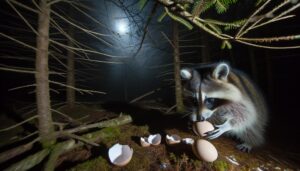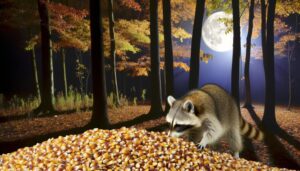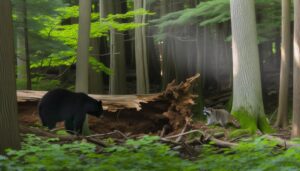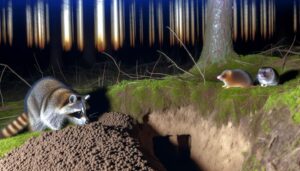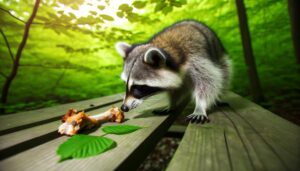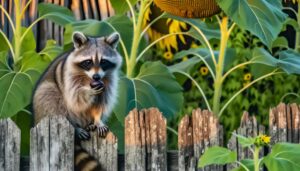Do Raccoons Eat Their Own Poop?
Raccoons do not typically engage in coprophagy or the consumption of their own feces. Their omnivorous diet naturally includes fruits, nuts, insects, and small vertebrates, adapting to seasonal availability and environmental conditions.
Scientific observations and controlled experiments have found no evidence of raccoons consuming feces, either in the wild or in captivity. Moreover, dietary analysis of raccoon scat reveals remnants of regular food items but no fecal matter.
Understanding raccoon dietary habits and behaviors can provide more insights into their ecological role and survival strategies.
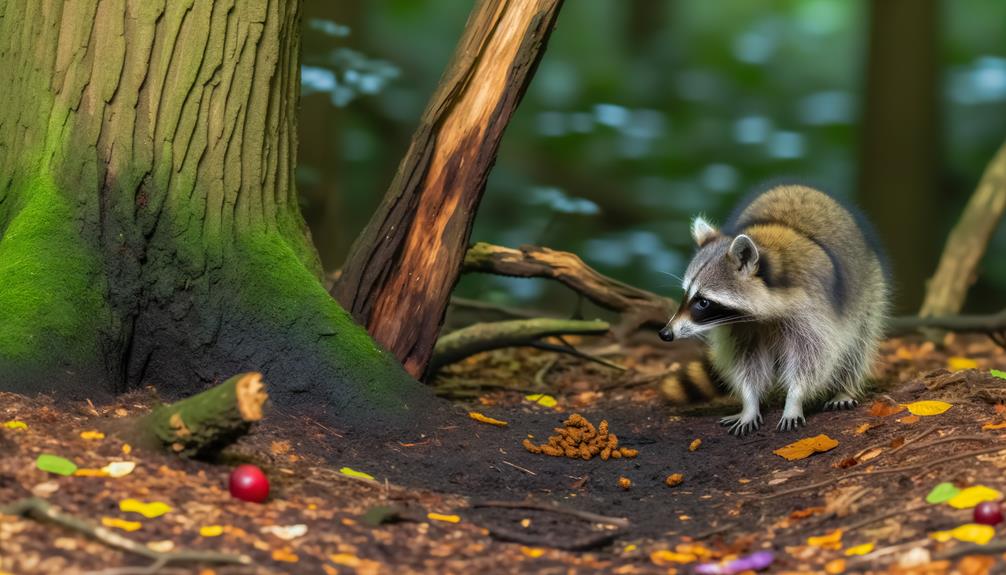
Key Takeaways
- Scientific observations and controlled experiments indicate raccoons do not exhibit coprophagic behavior.
- Dietary analysis of raccoon scat shows no evidence of fecal matter consumption.
- Captive studies confirm raccoons do not prefer or consume their own feces.
- Raccoons' diverse omnivorous diet provides necessary nutrients, reducing the need for coprophagy.
- Preventive measures include maintaining clean environments and providing balanced nutrition to avoid potential fecal consumption.
Understanding Coprophagy
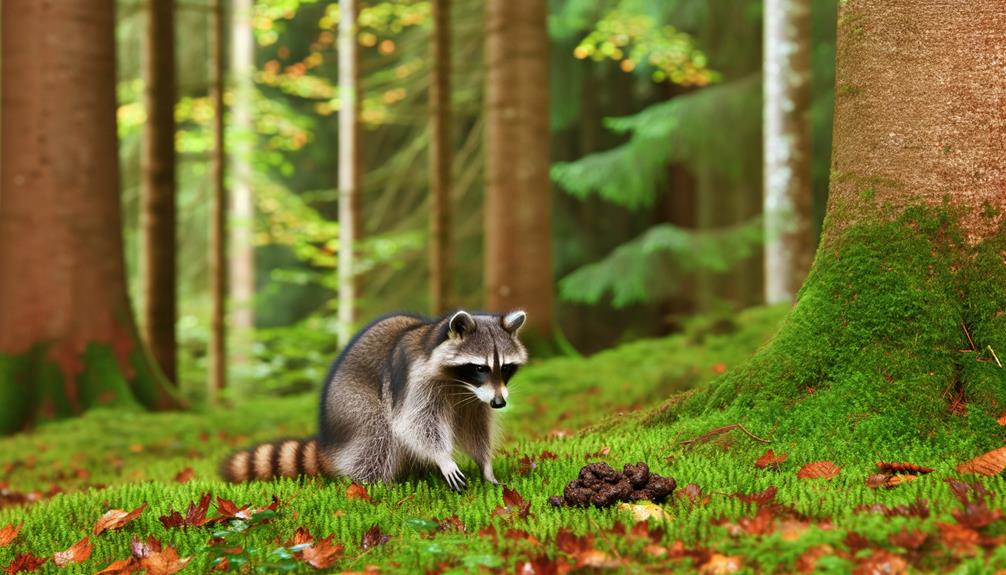
Coprophagy, the behavior of consuming feces, is observed across various species and serves multiple biological and ecological functions.
In some animals, such as rabbits and certain rodents, coprophagy is essential for nutrient absorption. These species produce two types of feces: a soft, nutrient-rich form consumed directly from the anus and a hard, waste form. Digestive processes in these animals are optimized by re-ingesting partially digested food, allowing for the extraction of vitamins, minerals, and other necessary nutrients.
Insects, such as dung beetles, also exhibit coprophagy, playing a critical role in nutrient cycling and soil aeration.
This behavior can also be seen in domestic animals like dogs, potentially due to dietary deficiencies, parasitic infections, or behavioral issues.
Raccoon Dietary Habits
Raccoons, being omnivorous and highly adaptable, exhibit a diverse diet that includes fruits, nuts, insects, small vertebrates, and human refuse. Their dietary flexibility allows them to thrive in various environments, from urban areas to dense forests. Raccoons' eating habits are essential, often influenced by seasonal availability and local resources. They are known to forage actively during the night, utilizing their dexterous front paws to manipulate food items and open containers.
Below is a table summarizing common food items in a raccoon's diet:
| Food Type | Examples |
|---|---|
| Fruits | Berries, apples, grapes |
| Nuts | Acorns, walnuts, pecans |
| Insects | Beetles, grasshoppers, ants |
| Small Vertebrates | Frogs, fish, birds |
| Human Refuse | Food scraps, garbage, pet food |
Their dietary habits are essential for their survival and ecological impact.
Health Implications
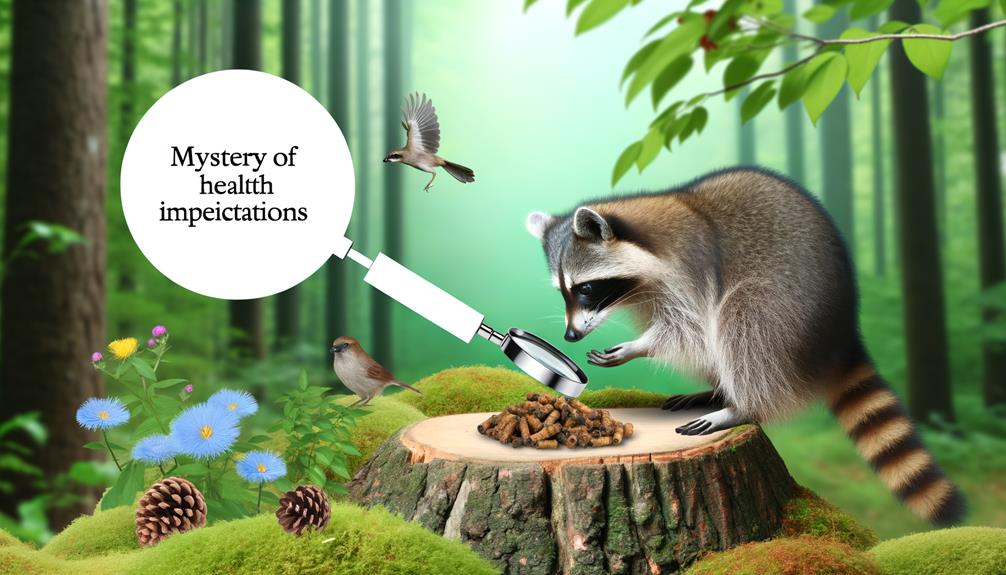
Understanding the health implications of raccoons' dietary habits requires an examination of both the benefits and potential risks associated with their omnivorous and opportunistic feeding behavior. Raccoons can consume a varied diet, which has significant health consequences:
- Nutrient Intake: Their diverse diet guarantees a broad intake of essential nutrients.
- Disease Transmission: Consumption of contaminated food or feces can result in zoonotic diseases.
- Parasite Load: Ingesting fecal matter may elevate their burden of intestinal parasites such as roundworms.
- Toxin Exposure: Their scavenging can expose them to harmful chemicals or spoiled food, leading to potential poisoning.
The intersection of these factors highlights the complexity of raccoons' health outcomes, requiring further research into their feeding behaviors and associated health risks.
Instinctual Behaviors
Raccoons exhibit various instinctual behaviors that are essential for their survival and social organization.
Their natural feeding habits include opportunistic foraging and consumption of a diverse diet, which can occasionally lead to coprophagic behaviors under specific circumstances.
Additionally, raccoons use feces for territorial marking, a behavior that serves to communicate occupancy and deter potential intruders.
Natural Feeding Habits
In the domain of natural feeding habits, raccoons exhibit a diverse and opportunistic diet driven by their omnivorous nature and adaptive foraging behaviors. These animals display impressive dietary flexibility, which allows them to thrive in various environments.
Their diet encompasses a wide range of food sources, including:
- Invertebrates: Insects, worms, and crustaceans are commonly consumed, providing essential proteins and nutrients.
- Plant Matter: Fruits, nuts, and seeds form a significant portion of their diet, particularly in seasons when these are abundant.
- Small Vertebrates: Raccoons occasionally prey on small mammals, birds, and amphibians, demonstrating their adaptability as hunters.
- Human Waste: Urban environments offer raccoons access to garbage, compost, and pet food, contributing to their opportunistic feeding behavior.
Understanding these feeding habits is essential for comprehending raccoon ecology.
Territorial Marking Signs
Alongside their diverse feeding habits, raccoons engage in various instinctual behaviors, including territorial marking, to establish and maintain their presence in a given area.
Territorial marking in raccoons is primarily achieved through scent marking. Raccoons possess specialized glands located near their anal region, which produce strong-smelling secretions. These secretions are deposited on objects within their territory, such as trees and rocks, serving as olfactory signals to other raccoons.
Additionally, raccoons may use their urine and feces to demarcate boundaries. This behavior not only communicates occupancy but also helps in minimizing conflicts with other raccoons by clearly delineating territorial limits.
Understanding these behaviors is vital for comprehending raccoon social structures and their interactions with the environment.
Scientific Observations
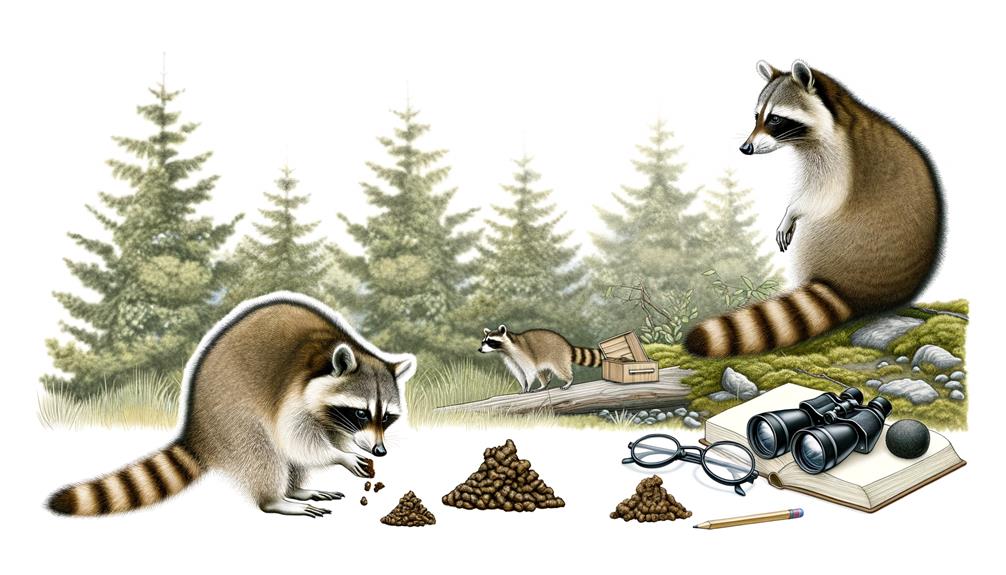
Scientific observations have revealed vital insights into raccoon behavior and physiology. Detailed studies of their feeding patterns, coupled with analyses of their digestive systems, provide an in-depth understanding of their dietary habits.
Additionally, behavioral study results contribute further evidence to assess whether coprophagy is a part of their natural interactions.
Observed Feeding Patterns
Extensive field studies have documented that raccoons exhibit highly varied feeding behaviors, frequently influenced by both environmental availability and seasonal changes. Their dietary patterns reflect significant adaptability and opportunism. Scientific observations identify several key feeding habits:
- Omnivorous Diet: Raccoons consume a wide range of foods, including fruits, nuts, insects, small vertebrates, and human refuse.
- Seasonal Variation: During warmer months, raccoons primarily forage for fruits and insects, while in colder seasons, they rely more on stored food and scavenging.
- Nocturnal Foraging: Being mainly nocturnal, raccoons forage at night, which reduces competition and predation risks.
- Water-Associated Feeding: They frequently forage near water sources, utilizing their dexterous forepaws to catch aquatic prey and wash food items.
These behaviors underscore raccoons' adaptive strategies to optimize nutrient intake.
Digestive System Analysis
Understanding raccoons' varied feeding behaviors requires an examination of their digestive system. Raccoons possess a monogastric digestive system characterized by a single-chambered stomach, similar to humans. Their digestive tract is relatively short, facilitating rapid processing of diverse food items ranging from fruits and insects to small vertebrates.
Enzymatic activity within the stomach and intestines is highly efficient, allowing for the digestion of complex carbohydrates, proteins, and fats. The cecum, though present, is underdeveloped, reflecting their omnivorous diet rather than a reliance on cellulose-rich plant matter. This digestive efficiency is essential for their survival in varied habitats but does not inherently lead to coprophagic behavior, which would require further behavioral analysis.
Behavioral Study Results
How have empirical observations contributed to our understanding of raccoons' potential coprophagic behavior?
Scientific studies have provided valuable insights through direct observation and controlled experiments. Researchers have documented several key behaviors regarding raccoons' dietary habits:
- Field Observations: Naturalistic observations in various habitats showed no significant evidence of coprophagy.
- Captive Studies: In controlled environments, raccoons displayed no preference for fecal matter as a food source.
- Dietary Analysis: Examination of raccoon scat primarily revealed remnants of fruits, insects, and small vertebrates, with no fecal matter consumption.
- Behavioral Experiments: Tests involving food scarcity and fecal availability indicated that raccoons did not resort to coprophagy under typical conditions.
These findings collectively suggest that coprophagy is not a common or natural behavior in raccoons.
Preventive Measures
Implementing preventive measures can greatly reduce the likelihood of raccoons engaging in coprophagic behavior. Ensuring a clean and sanitary environment is paramount. Regular cleaning of raccoon habitats, including prompt removal of feces, minimizes exposure.
Providing balanced nutrition can deter raccoons from seeking alternative nutrient sources found in feces. Enrichment activities, such as puzzle feeders and varying dietary options, can reduce boredom and stress, which are potential triggers for coprophagy.
Additionally, limiting access to other animals' feces through secure enclosures and barriers can be effective. Monitoring health and behavior allows for early intervention if coprophagic tendencies arise.
These measures collectively contribute to a healthier, more controlled environment, thereby mitigating the risk of coprophagic behavior in raccoons.
Conclusion
The phenomenon of coprophagy, while observed among various species, appears not to be a prevalent behavior in raccoons. Analysis of their dietary habits, instinctual behaviors, and scientific observations indicate that such actions are not a common characteristic. While occasional instances may occur, they are not indicative of typical raccoon behavior.
Understanding these behaviors further underscores the importance of preventive measures to maintain both wildlife health and ecological balance. Continued research is essential for thorough insights into raccoon dietary practices.

